

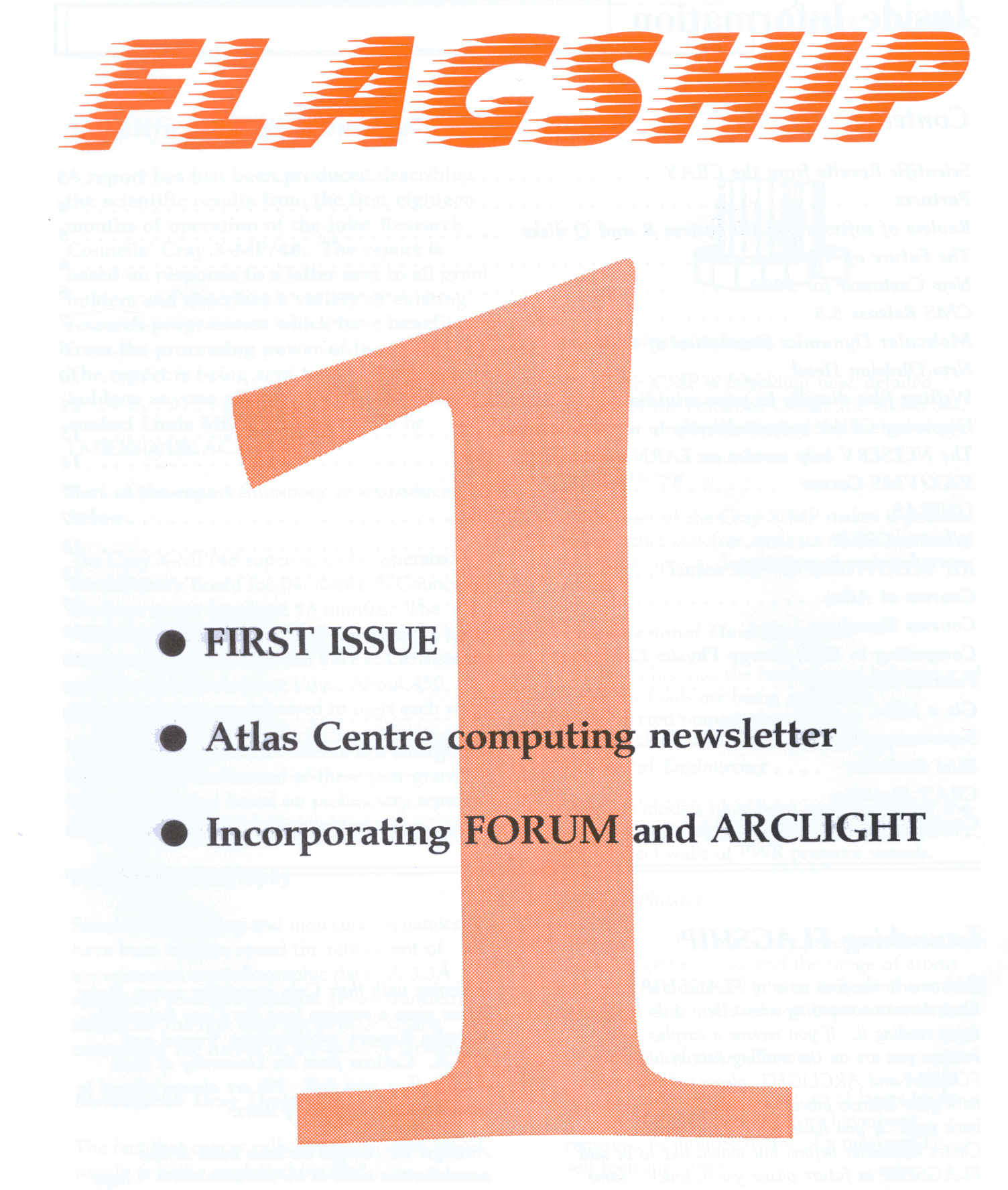
Welcome to the first issue of FLAGSHIP, the Atlas Centre's new computing newsletter. I do hope you enjoy reading it. If you receive a surplus copy, because you are on the mailing lists of both FORUM and ARCLIGHT, please will you return both your address labels to me at the address on the back page. If you have not received either Atlas Centre newsletter before, but would like to be sent FLAGSHIP in future please get in touch - same address.
In this issue the big news is about the SERC/IBM Joint Study Agreement, explained by Paul Thompson. To show what some users are achieving with their Cray computing power, Roger Evans gives a preview from the Cray Scientific Results Report, and Benham Vessal and C.R.A. Catlow from the University of Keele describe their own field. We are always pleased to include articles written by users.
Amongst the changes we have made in this newsletter are those to the statistics pages, I hope we have chosen graphs that you will find useful. If you have any comments on this or any other aspect of FLAGSHIP please tell us.
A report has just been produced describing the scientific results from the first eighteen months of operation of the Joint Research Councils' Cray X-MP/48. The report is based on response to a letter sent to all grant holders and describes a variety of existing research programmes which have benefited from the processing power of the X-MP/48. The report is being sent to all Cray grant holders; anyone else wanting a copy should contact Linda Miles (0235-445790 or LMILES@UK.AC.RL.IB).
Part of the report Summary is reproduced below.
The Cray X-MP/48 supercomputer operated for the Advisory Board for the Research Councils has been in use for about 18 months. The reliability and performance of the machine have been exceptionally high and have led to a steady reduction in maintenance time. About 450 processor hours are delivered to users each week.
The true scientific achievements will emerge only after the first round of three year grants reach fruition but based on preliminary reports the following must be highlighted.
Simulated annealing and molecular dynamics have been used to speed the refinement of experimental crystallographic data. A 3.3A resolution structure of rabbit serum transferrin shows for the first time the peptide chains connecting the halves of the bi-lobal molecule.
The fact that cancer cells have a reduced blood supply is being exploited by designing chemotherapeutic drugs which are active only when reduced.
The Cray X-MP is providing new, detailed models of the Antarctic Ocean, the North Sea, the upper atmosphere and global meteorology.
The power of the Cray X-MP makes it possible to construct bias-free analyses of the clustering and geographical distribution of certain human cancers.
New insights into the fundamental behaviour of turbulent fluids are being gained by sophisticated numerical modelling.
Detailed models have been constructed for the elastic-plastic behaviour and crack propagation in the steel walls of PWR pressure vessels.
The power of all four Cray processors have been linked together to extend the range of atoms that can be modelled and to increase the accuracy of atomic collision cross sections.
Previous objections to the use of lasers to drive high field particle accelerators have been removed by the discovery of a new non-linear self-focusing effect.
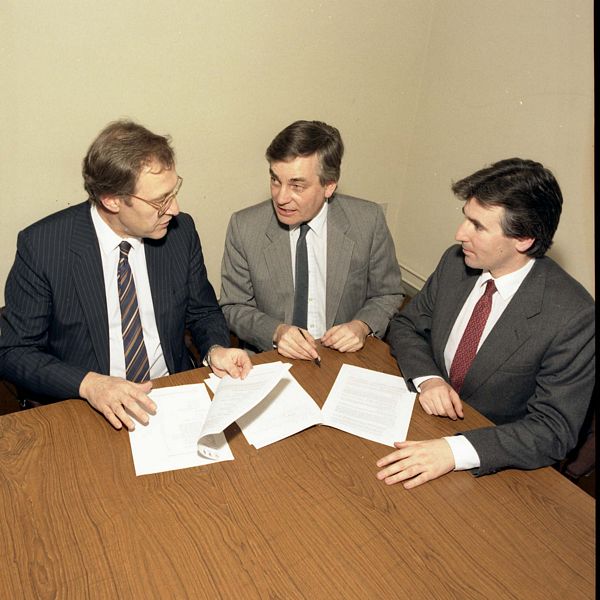
On Thursday 22 December SERC and IBM signed a Joint Study Agreement. The agreement provides for collaboration between IBM and RAL over a two year period and will have significant impact on computing at the Atlas Centre.
The joint study will have as a primary objective the creation of a centre of excellence for IBM technical computing. This will involve work on the exploitation of vector and parallel processing techniques and in the visualisation of data.
As part of the agreement the 3090-200E at RAL will be upgraded in stages to a 3090-600E with six vector facilities, 256MB of main storage and 1GB of expanded storage. More 3480 tape drives will be added together with 20GB of additional disk space and a 3745 communications processor.
The first stage of the upgrade was carried out on Monday 2 January and we are now running a 3090-400E (i.e. 4 processors) with 128MB main storage an 1GB of expanded storage. The remaining main storage will have been installed by the time you read this. The tape drives and communications processor have been delivered and will be installed shortly.
This major upgrade makes available to SERC an unprecedented amount of mainframe computer power for advanced computing and augurs well for the future.
Under the Joint Study Agreement staff from the Atlas Centre, together with staff from IBM, will investigate the applicability of the vector and parallel processing capabilities of such a powerful machine to the numerically intensive computational problems tackled by the users of the Atlas Centre.
The Agreement also envisages significant investigation of the use of advanced visualisation techniques from a variety of workstations.
Further details of these initiatives and progress reports will be issued from time to time during the course of the two-year agreement
IBM and the Atlas Centre are looking for users whose research needs access to this highly sophisticated type of computing and who are prepared to put time and effort into exploiting them. We are particularly looking for a small number of partners who need large amounts of vector or parallel computing and/or very large amounts of memory.
At the moment we are setting up schemes for selecting the right type of partners for this work and will publish the arrangements in due course. In the meantime if you feel that you have this type of very large-scale requirement, and maybe a need for advanced visualisation techniques, please drop me a line.
Amorphous materials do not possess the long-range order of crystalline substances. Glasses are usually defined as a sub-class of amorphous materials which exhibit a glass transition and are formable by quenching from the melt. At the glass transition the amorphous solid shows an abrupt change in heat capacity or thermal expansivity from crystal-like to liquid-like values. Glasses include numerous oxides, chalcogenides, halides, polymers, organic glasses and amorphous metals.
Molecular dynamics (MD) is a technique that can yield unique information on the structure of glasses. The basic principles of this technique are simple: a simulation box is specified. The box, which usually contains several hundred particles, is repeated periodically throughout space, thus generating an infinite system. The simulation therefore includes no effects arising from the surface. In running the simulation, the following procedure is then applied:
The MD method has been used for simulating several different glassy systems, e.g. Lennard-Jones glasses, vitreous alkali halides, B2O3 , and SiO2 glasses. Several workers have simulated the structure of vitreous silica using a purely ionic pair potential. They have been successful in reproducing the radial distribution functions (RDF) for silica glass but their calculated bond angle distributions (BAD) did not agree with experiment. (For a one-component system the RDF is related to n(r)dr, the average number of particles at distances between r and r + dr. For systems with more than one component e.g. for an ionic system g+ -(r) is defined by placing a positive ion at the origin and restricting n(r) to negative ions.) This inadequacy was due mainly to the omission from their models of terms modelling the covalent bonding in SiO2 .
We have investigated this problem using our MD code FUNGUS which runs efficiently on the X/MP. Indeed it currently achieves a speed of 90 MFlops. We have developed a potential model for simulating the structure of silica glass which gives both good RDF and BAD for the simulated glass (see Fig. 1-2) and also gives the correct structure for alpha-quartz. We have achieved this success by including angle bending terms in our potential model to model the covalent character of the bonds in SiO2 . We also have modified our MD code in order to undertake constant pressure MD simulations. This new development enables us to study phase transitions. We have started with the beta-cristobalite crystal structure at 300 K, and 648 ions in our simulation box. We have run the simulation at a constant pressure of 0 kb.
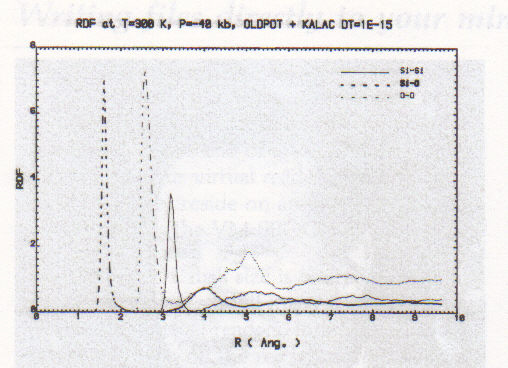
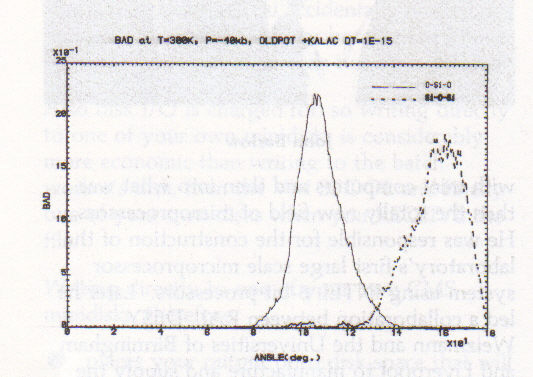
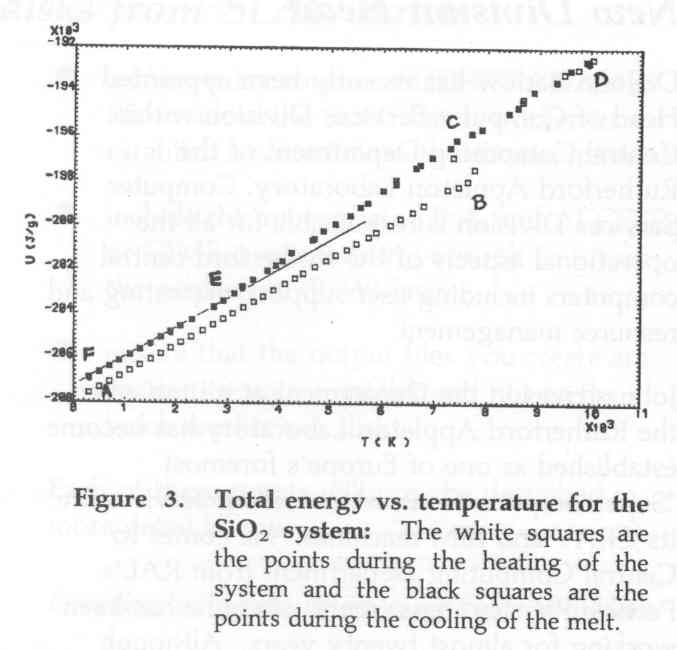
We run our system at 300 K for a total of 2000 steps. Then the system is subject to a cyclic heating. Each cycle has a period of 2000 steps. We use a temperature interval of 200 K between the two cycles. While the temperature of the crystal is increasing the behaviour of the system is studied to detect melting. After melting, the liquid is heated-up to about 3000 K above the melting point, then the process is continued with the temperature interval of -200 K between two cycles, i.e. the liquid is cooled down in the same stepwise fashion.
Figure 3 shows the plot of internal energy, U, against the temperature during heating and cooling of the system. The crystal is heated from A to B, melts between B and C, and the liquid is heated from C to D. The system is then cooled down from D to point F (see Fig. 3). A clear first order transition occurs between points B and C from which the melting point, Tf = T(B or C) , and the latent heat, Lf = U(C) - U(B) are obtained. The specific heats for solid and liquid are obtained from the slope of the lines AB and DE. During the cooling of the system from D recrystallisation does not occur, and the points from C to E represent the supercooled liquid. At a temperature of around T = Tf /2.5 the specific heat of the system is observed to decrease from the liquid value to the crystal value (slope of lines DE and EF). This behaviour is characteristic of glass formation and we identify this temperature as the glass transition temperature, Tg, of the system.
Each time-step takes about .3 sec on the X/MP, so the whole run takes about 17 hours on the X/MP. As can be seen the X/MP is essential for this work specially if longer cooling times for annealing of the glass is going to be used.
Dr John Barlow has recently been appointed Head of Computer Services Division within Central Computing Department of the Rutherford Appleton Laboratory. Computer Services Division is responsible for all the operational aspects of the Rutherford central computers including user support, marketing and resource management.
John arrives in the Department at a time when the Rutherford Appleton Laboratory has become established as one of Europe's foremost Supercomputer Centres providing services on its CRAY and IBM machines. He comes to Central Computing Department from RAL's Particle Physics Department where he has been working for almost twenty years. Although trained as a physicist, he has worked extensively on a wide variety of computer projects throughout his career. He still remembers his first computing assignment, the evaluation of the square root of a real number. The routine was to execute on a computer comprised of hundreds of little glass bottles, each glowing with a cosy red light! - a long way away from the sophisticated microchips of today's technology.
He started his career at CERN working as an experimental physicist and computing on a Ferranti Mercury computer. After several years at CERN, he joined the Rutherford High Energy Laboratory with specific responsibilities for the provision of computer software for the Bubble Chamber Research group in the then High Energy Physics Division. His work in the group started with the provision of a wide variety of scientific packages which were all Fortran coded and ran on the laboratory's IBM 360/75 and later 360/195 mainframes. During this period he established firm contacts and friends in the Computing Division, many of whom are now with him in Computer Services Division. Some years later, his activities extended into the area of real time programming with mini computers and then into what was then the totally new field of microprocessors. He was responsible for the construction of the laboratory's first large scale microprocessor system using INTEL 8-bit processors. Later he led a collaboration between RAL, DESY, Weizmann and the Universities of Birmingham and Liverpool to manufacture and supply the very powerful bit-sliced 370/E emulator of the IBM 370 CPU to many European Institutes. For the past three years, he has been back in CERN working on the design and development of the computer control system for the DELPHI LEP experiment.
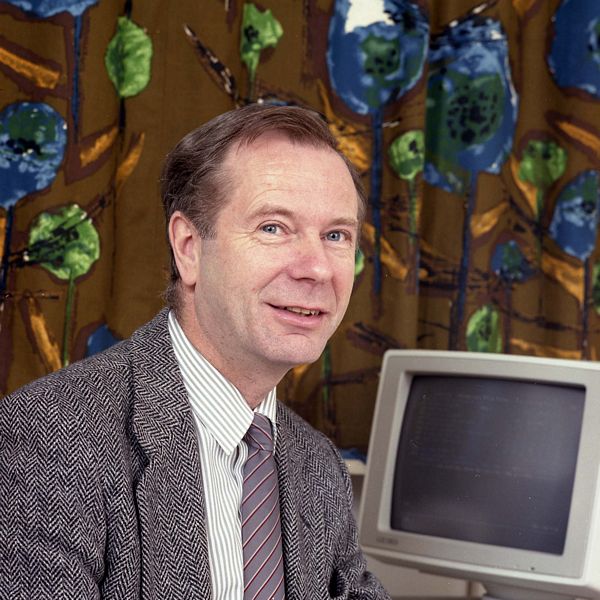
He said: I am delighted to have the opportunity to take over the responsibility for the management of Computer Services Division, particularly at this very exciting time of the step into the Supercomputer era.
The UNIversal RASter system, a suite of packages designed to produce high quality graphical display, is now being installed on a wide variety of SERC machines. Release 5.4 software has arrived for the following machines and systems:
| IBM 3090 | VM/CMS |
| IBM 3090 | OS/MVS |
| IBM PC XT and PS/2 | DOS |
| IBM RT6150 | AIX |
| SUN3 | SUN OS |
| VAX | VMS |
| CRAY | COS |
| NORSK DATA 500 | SINTRAN |
UNIRAS is a complete, stand-alone system, from the interactive utilities down to the device drivers.
The interactive utilities enable the non-programmer to create a wide variety of presentation graphics and charts, contour plots and 3D perspective views of surfaces.
At the next level, eight application packages are available to Fortran 77 programmers. Application areas include business graphics, contour plotting, 3D displays, cartography based on a world database, image data presentation and seismic/geophysical displays.
All these sit on top of a user callable general raster graphics package. Output can be to any one of a very large range of display terminals or hard-copy devices, to proprietary device-independent metafiles, or to a GKS metafile. An implementation of GKS is part of the UNIRAS, but is separate from the raster system outlined above. It has its own, more limited range of device drivers, and it communicates with the rest of UNIRAS only through metafiles.
Please note that UNIRAS Ltd provide no implementations of either GKS or the interactives utilities for either the Cray COS or the current PC DOS systems.
There is no introductory manual from UNIRAS Ltd, but a good, readable introduction is "UNIRAS: An overview", by Tom Brown of the Computer Service, University of Sussex. Copies are available from Muriel Herbert (0235-44-5272) (MANUALS@UK.AC.RL.IB), and copies in the Sussex house style, optionally with a binder, can be purchased direct from the author (CCFD6@UK.AC.SUSSEX.CLUSTER).
There are sixteen user manuals for the complete UNIRAS system. The originals are expensive, and we recommend the purchase of the UMRCC low-cost reproductions. These should be ordered through Muriel Herbert, who will supply prices on request. It is not necessary to order complete sets; the Sussex overview can assist users decide which of the manuals would be useful to them. Please note that the next release of the software, Release 6, is major, and will largely make obsolete the current documentation. We will probably install it towards the end of this year.
Plans are in hand to offer a guide to the use of the subroutine libraries, and beginners guides to the interactive utilities. These will be based on documentation produced by the NERC Computing Centre, Wallingford.
On March 20 there will be a seminar on UNIRAS at the Atlas Centre, Rutherford Appleton Laboratory. This will include a demonstration of the interactive utilities.
On June 13,14 and 15 tutorials and workshops will be held at the Atlas Centre. Please contact Mary Shepherd (0235-445635) (MRS@UK.AC.RL.IB) if you would like to attend either the seminar or the tutorials.
CGM (Computer Graphics Metafile) is an ISO Standard for the storage and transmission of pictures. CGMs differs from GKS metafiles in that CGMs store all the attributes for a picture independently for each picture whereas GKS metafiles are a record of a GKS session. This means that in a GKS metafile it is not easy to select frames at random as attributes in one picture may affect subsequent pictures. In CGM however each picture includes all the information necessary for redisplay.
The standard defines three types of encoding:
RAL-GKS version 1.11 is now able to offer CGM character encoded metafiles as well as GKS metafiles. CGM has been shown to be between 20-30% the size of the corresponding GKS metafile, which has advantages in storing and transmission over the network. CGM is now accepted by GKSMVIEW and by HARDCOPY (for printing on the Xerox 4050, Versatec 9242 or IBM 4250) and is now the preferred metafile format. See Help GRAPhics CGM for details.
Because CGM is an International Standard it is readable by any conforming graphics package, whereas GKS metafiles are different in various GKS implementations and interpretation does not necessarily produce the desired result. In the near future UNIRAS will support CGM (Binary and Clear text encodings).
At RAL an interpreter for all CGM encodings is being developed initially for the Video system and Iris workstation, but it is hoped to include other PCs and workstations in the future.
In the last (sic!) FORUM, you may have noticed the RIP MUGWUMP article announcing the imminent demise of SMOG, MUGWUMP and much more. We were short of space at the time, so kept details to a minimum. Here's the full story.
When VM/XA became the user level of VM (back in October 1988), some parts of the old style graphics systems stopped working. Despite strenuous attempts to revive them (and a little success), some methods of working remain broken. When the current CMS system (4.14) is replaced by a more up-to-date version (5.5) in April this year, even some of the working routes will fail.
The systems concerned are the SMOG, MUGWUMP and GINO packages under CMS and MVS, the DESPOOL, FR80REPL and MUGWUMP 3 virtual machines under CMS, the GRAPHICS, GVIEW, GCOPY, GERASE, LISTGR commands under CMS and the PRIMEIBM facility available on some PRIME and GEC systems.
All users who currently rely on any of these packages, commands or methods of working should therefore convert to GKS and NAG immediately. We ran a course last November on how to convert and are repeating this course on February 23.